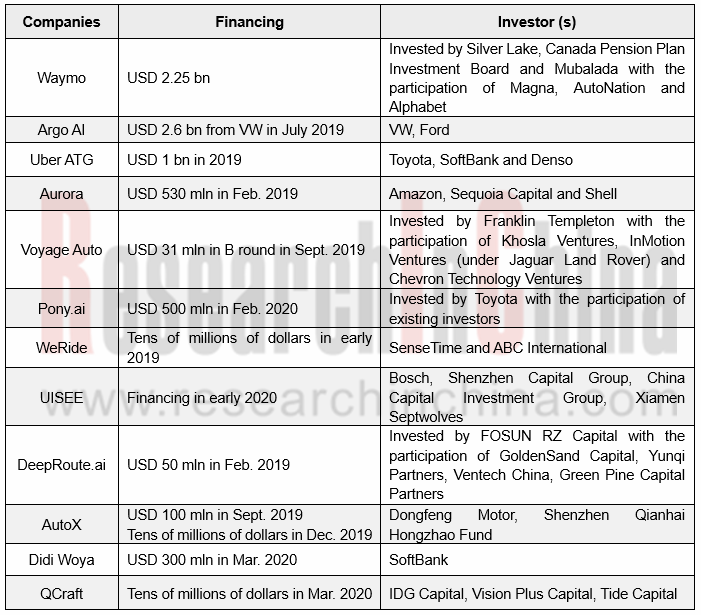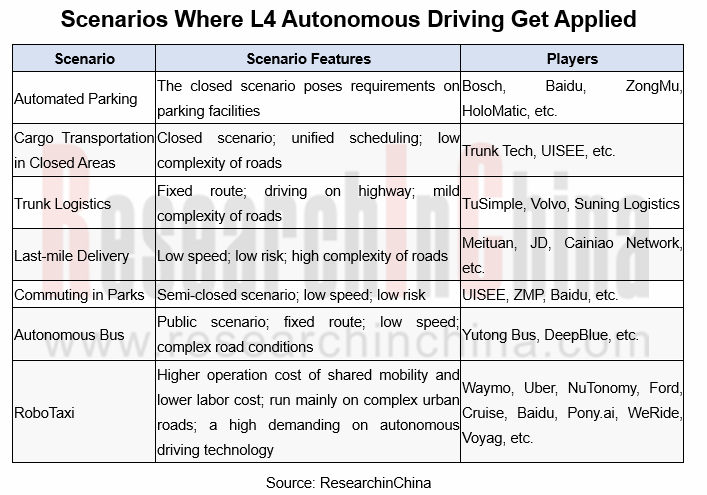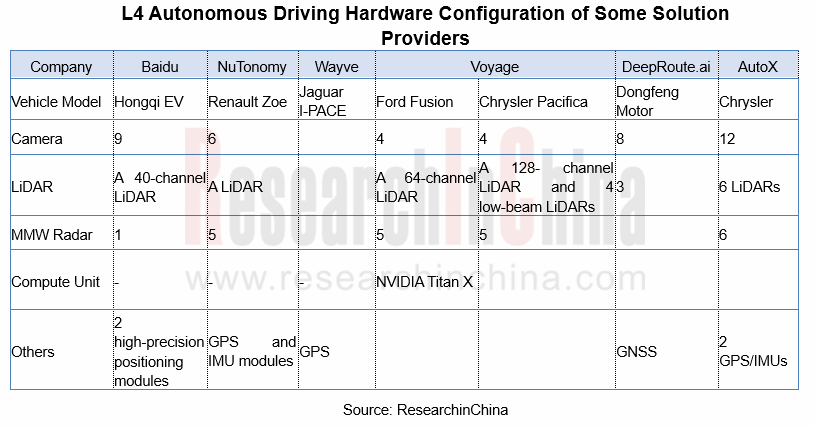Giants gain high finance.
Progress of L4 autonomous driving is greatly hampered over the recent two years, causing OEMs’ and Tier 1 suppliers’ delay in L4 launches. Yet, the top L4 companies still raised huge funds in the past year.

In 2019, Baidu, Pony.ai and WeRide succeeded in commercial pilot of Robotaxi on complex urban roads in limited areas, a crucial step for L4 autonomous driving in China.
L4 autonomous driving technologies starts to find real application but gets deployed by most players first in one scenario or two as the current L4 cannot be perfectly suited to all driving scenarios.
It is shown from the planning of the OEMs and the providers of technical solutions for autonomous driving that L4 autonomous driving will be commercialized in limited scenarios ahead of open scenarios in the following three to five years.
Baidu, UISEE, DeepBlue and Trunk Tech all have conducted L4 trials in limited scenarios such as parks, ports, and airports. Besides, Baidu, Momenta, Bosch, ZongMu and UISEE are vigorously deploying in the parking lot scenario.
Deployments in open scenarios cover Robotaxi on urban roads and autonomous trucks on the expressways. In the Robotaxi field, Waymo, Baidu, Pony.ai, and WeRide have carried out pilot projects in both China and the U.S. in specific areas of a city, manned by safety officers, and WeRide is already fully open to the public in Nov.2019. Software & hardware technology iteration and larger-scale tests are essential for open Robotaxi in wider areas.

Technically, the current L4 autonomous vehicles for tests (or trial operation) are largely provided with the single-car intelligence solution. For safer autonomous driving, solution providers make vehicle’s environment perception capability optimized ever. For instance, Voyage’s G2 autonomous vehicle carries Velodyne's VLS-128 LiDAR system with a detection range up to 300 meters, tripling the capability of the 64-channel LiDAR installed on the 1st-Gen autonomous vehicle. Boasting 29 cameras, Waymo’s next-generation autonomous driving system enables a detection range of 500 meters whist improving LiDARs’ performance significantly.
Also, it is of vital importance to enhance vehicle’s motion perception competence. High-precision positioning can be realized by integrating high-precision positioning modules (composed of 5G modules, IMU and HD maps).

In the short term, either single-car intelligence solution or strong field terminal solution fulfills L4 autonomous driving in the confined areas, but in the long run, collaborative vehicle infrastructure system (CVIS) is the mainstream technology roadmap for L4 autonomous driving. Through CVIS, the vehicle is fully connected to the “X” as spatiotemporal dynamic traffic information are collected and integrated whilst the active safety control of vehicle and the collaborative management on roads are done for safer running of autonomous vehicle.
By analyzing the test data, Baidu concludes that CVIS can solve 54% of the problems encountered in road tests and 62% of the takeovers incurred by single-car intelligence, adding redundancy for autonomous driving safety.
Passenger Car Mobile Phone Wireless Charging Research Report, 2025
Automotive Wireless Charging Research: Domestic Installation Rate Will Exceed 50%, and Overseas Demand Emerges as Second Growth Driver.
The Passenger Car Mobile Phone Wireless Charging Research Repor...
Automotive 4D Radar Industry Research Report 2025
4D radar research: From "optional" to "essential," 4D radar's share will exceed 50% by 2030.
1. 4D imaging radar has transformed from an "optional" to a "must-have" sensor.
4D radar adds the detecti...
China Automotive Multimodal Interaction Development Research Report, 2025
Research on Automotive Multimodal Interaction: The Interaction Evolution of L1~L4 Cockpits
ResearchInChina has released the "China Automotive Multimodal Interaction Development Research Report, 2025"...
Automotive Vision Industry Report, 2025
Automotive Vision Research: Average Camera Installation per Vehicle Reaches 5.2 Units, and Front-View Tricam Installation Exceeds 1.2 Million Sets.
From January to September 2025, the total installa...
Automotive Infrared Night Vision System Research Report, 2025
Automotive night vision research: The rise of infrared AEB, with automotive infrared night vision experiencing a 384.7% year-on-year increase from January to September.
From January to September 2025...
New Energy Vehicle Cross-Domain (Electric Drive System and Powertrain Domain) Integration Trend Report 2025-2026
Electric Drive and Powertrain Domain Research: New technologies such as three-motor four-wheel drive, drive-brake integration, and corner modules are being rapidly installed in vehicles.
Electric dri...
Analysis on Desay SV and Joyson Electronic's Electrification, Connectivity, Intelligence and Sharing, 2025
Research on Desay SV and Joyson Electronic: Who is the No.1 Intelligent Supplier?
Both Desay SV and Joyson Electronic are leading domestic suppliers in automotive intelligence. "Analysis on Desay SV ...
OEMs and Tier 1 Suppliers' Cost Reduction and Efficiency Enhancement Strategy Analysis Report, 2025
ResearchInChina released the "OEMs and Tier 1 Suppliers' Cost Reduction and Efficiency Enhancement Strategy Analysis Report, 2025", summarizing hundreds of cost reduction strategies to provide referen...
Automotive Fixed Panoramic Sunroof and Smart Roof Research Report, 2025
With the intelligent application of car roofs as the core, this report systematically sorts out a series of new products such as fixed panoramic sunroof/openable sunroof, ceiling screen, roof ambient ...
Automotive-Grade Power Semiconductor and Module (SiC, GaN) Industry Research Report, 2025
SiC/GaN Research: Sales volume of 800V+ architecture-based vehicles will increase more than 10 times, and hybrid carbon (SiC+IGBT) power modules are rapidly being deployed in vehicles.
Sales volume o...
Cockpit Agent Engineering Research Report, 2025
Cockpit Agent Engineering Research: Breakthrough from Digital AI to Physical AI
Cockpit Agent Engineering Research Report, 2025 starts with the status quo of cockpit agents, summarizes the technical ...
Prospective Study on L3 Intelligent Driving Technology of OEMs and Tier 1 Suppliers, 2025
L3 Research: The Window of Opportunity Has Arrived - Eight Trends in L3 Layout of OEMs and Tier 1 Suppliers
Through in-depth research on 15 OEMs (including 8 Chinese and 7 foreign OEMs) and 9 Tier 1 ...
China Commercial Vehicle IoV and Intelligent Cockpit Industry Research Report 2025
Commercial Vehicle IoV and Cockpit Research: The Third Wave of Passenger Car/Commercial Vehicle Technology Integration Arrives, and T-Box Integrates e-Call and 15.6-inch for Vehicles
I. The third wav...
Intelligent Vehicle Electronic and Electrical Architecture (EEA) and Technology Supply Chain Construction Strategy Research Report, 2025
E/E Architecture Research: 24 OEMs Deploy Innovative Products from Platform Architectures to Technical Selling Points
According to statistics from ResearchInChina, 802,000 passenger cars with domain...
Research Report on Intelligent Vehicle Cross-Domain Integration Strategies and Innovative Function Scenarios, 2025
Cross-Domain Integration Strategy Research: Automakers' Competition Extends to Cross-Domain Innovative Function Scenarios such as Cockpit-Driving, Powertrain, and Chassis
Cross-domain integration of ...
China Autonomous Driving Data Closed Loop Research Report, 2025
Data Closed-Loop Research: Synthetic Data Accounts for Over 50%, Full-process Automated Toolchain Gradually Implemented
Key Points:From 2023 to 2025, the proportion of synthetic data increased from 2...
Automotive Glass and Smart Glass Research Report, 2025
Automotive Glass Report: Dimmable Glass Offers Active Mode, Penetration Rate Expected to Reach 10% by 2030
ResearchInChina releases the Automotive Glass and Smart Glass Research Report, 2025. This r...
Passenger Car Brake-by-Wire (BBW) Research Report, 2025
Brake-by-Wire: EHB to Be Installed in 12 Million Vehicles in 2025
1. EHB Have Been Installed in over 10 Million Vehicles, A Figure to Hit 12 Million in 2025.
In 2024, the brake-by-wire, Electro-Hydr...